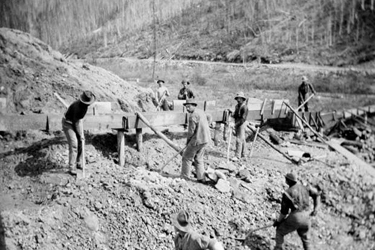
The Klondike gold rush is among the most interesting gold rushes not only in Canada but in North America as well. This is because it occurred in a unique climate and environment that forced miners to make adjustments to cold temperatures and the mining techniques used at the time. The Klondike gold rush had a significant effect on settlements, tourism as well as the local, regional and national economy.
However, while people were striving to achieve their dreams during the Klondike gold rush, little did we know that the footprints we leave behind would make a lasting impact on the environment. Herein is an overview of some of the environmental effects of the Klondike gold rush.
1. It Led To Large Scale Deforestation
One of the first environmental effects of the Klondike gold rush was large scale deforestation. There are three main aspects that led to deforestation in the Klondike region. First, the miners needed timber to build the boats that they used to sail along the Yukon River. Second, they needed wood to use as fuel for the steamboats. Thirdly, the miners needed to clear up land to make room for the increasing human population.
Deforestation affected the environment both along the gold creeks and along the shores of Lake Bennett and Lake Lindeman. People built their boats at the shores of these lakes after completing the White Pass and Chilkoot Pass. Boat construction consumed large amounts of timber. The tree line was pushed back all the way to the surrounding hills within a short time.
Lake Bennett quickly became the center of boat building. A small settlement of tents grew to become a town complete with amenities for the boat builders and their families. Coal and oil were not readily available in the Yukon at the time.
As such, steamboats were dependent on wood. The transport of miners led to commercial-scale deforestation by steamer companies. It is worth noting that felling timber was not the only cause of deforestation. On occasion, humans accidentally set forest fires which did significant damage to the vegetation.
2. Mining Methods Changed the Klondike Landscape
The most notable human environmental impact from the Klondike gold rush was brought on by the mining methods. One of the earliest and easiest ways to get to gold was to dig a shaft down to the bedrock. Miners had first to clear the area where they would dig the shafts. Also, they had to use timber to line the shafts of the mines and also make mining tools such as sluice boxes and rockers.
The introduction of new mining techniques such as hydraulic mining and dredging at the turn of the century only made the situation worse. The high-pressure hoses used on hillsides utterly destroyed the landscape. Decades after the Klondike gold rush ended, the hills still had the scars left behind by hydraulic nozzles.
3. It Affected the Aquatic System
Water was a precious resource during this gold rush. It was used to clean and sluice gold. Miners used flumes and ditches to direct water to their claims (mining areas). They diverted streams into these flumes and as a result, affected the aquatic system.
Altering one aspect of the system, such as flowing water, had unforeseen consequences. This water often disappeared when it was needed the most or reappeared in rather frustrating ways. Creeks would often overflow in spring and miners had a water shortage in the late summer.
Another notable way that the Klondike gold rush impacted the aquatic system was water pollution. The runoff from the hills and mines found its way into rivers and streams leading to large scale water pollution. Human and animal waste also compounded this problem. Silty waters impede the survival and flourishing of aquatic life. The overgrowth of aquatic plant life affected the water flow. These and other factors, such as overfishing led to a significant decline in fish species populations in this area of Canada.
4. It led to Native Game Depletion
Overhunting was another environmental consequence of the Klondike gold rush. It had a profound impact on the availability of animals. As thousands of miners migrated into the Yukon area, more game was required to feed them. The Canadian tribes increased their hunting, fishing and trapping activities to sell surplus food to the miners.
The fur trade that accompanied the gold rush also worsened the problem. Miners forced animals to move elsewhere by disrupting the environment. In addition, large scale deforestation, forest fires and overburden clearing destroyed animal habitats.
The Klondike gold rush in Canada had more effects on the environment, including soil erosion, disease, soil pollution and drought. This gold rush is renown by Canadians and Americans as one of the last major gold rushes. It had profound effects on those who took part and a lasting impact on the Klondike region environment that is still evident more than a century later.
